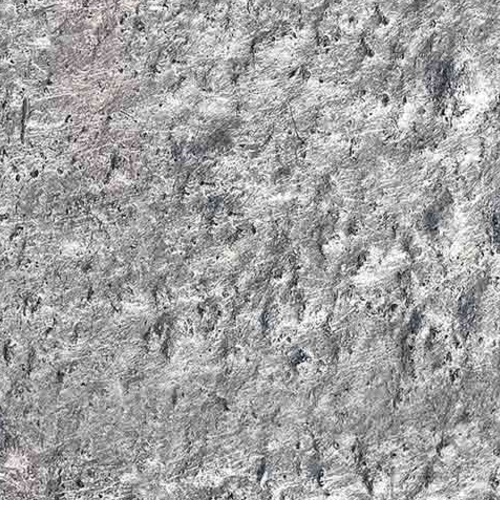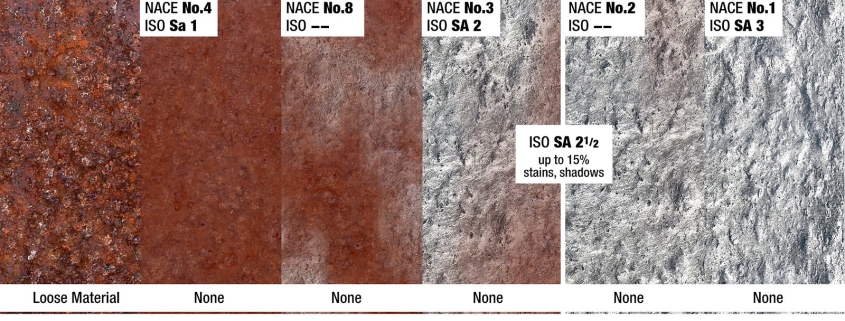Rørledningsbeskyttende belægninger: Overfladeforberedelsesstandarder
Indledning
Overfladeforberedelse er afgørende i industrier som olie og gas, marine og infrastruktur for at sikre, at beskyttende belægninger klæber korrekt og fungerer godt over tid. Adskillige internationale standarder regulerer niveauet af overfladerenhed, der kræves før påføring af belægninger. Denne blog fokuserer på de almindeligt omtalte standarder for overfladeforberedelse: ISO 8501-1 Sa 2½, SSPC-SP 10, NACE nr. 2, og SIS 05 59 00 Sa 2½.
1. ISO 8501-1 Sa 2½: Standarder for overfladebehandling
Objektiv:
ISO 8501-1 er en internationalt anerkendt standard, der specificerer renhedsgrader for ståloverflader efter sandblæsning. Sa 2½ refererer til en omfattende blæserensning, der fjerner næsten al rust, mølleskala og gamle belægninger og efterlader kun små skygger eller misfarvninger.
Nøgleaspekter:
Overflade udseende: Overfladen skal være fri for møllebelægninger, rust og gamle belægninger, med kun små rester af pletter eller misfarvning fra rust eller møllebelægning tilbage. Mindst 95% af overfladearealet skal være fri for synlige forurenende stoffer.
Visuel standard: ISO 8501-1 Sa 2½ giver visuelle eksempler på acceptable renhedsniveauer, hvilket gør det muligt for inspektører at sammenligne den forberedte overflade med disse referencer for at sikre overholdelse.
2. SSPC-SP 10: Næsten hvid metalblæsningsrensning
Objektiv:
SSPC-SP 10, også kendt som næsten-hvid metalblæsningsrensning, er en standard, der specificerer niveauet af overfladerenhed, der kræves for ståloverflader før belægning. Det sigter mod at fjerne næsten alle synlige forurenende stoffer, og efterlader en overflade med kun en smule pletter.
Nøgleaspekter:
Overflade renhed: Mindst 95% af hvert enhedsareal skal være fri for al synlig olie, fedt, støv, snavs, mølleskala, rust, belægning, oxider, korrosionsprodukter og andre fremmedlegemer. Den resterende 5% kan indeholde let misfarvning, men ingen signifikante aflejringer.
Overfladeprofil: SSPC-SP 10 kræver, at overfladeprofilen er ru nok til at sikre god belægningsvedhæftning, typisk opnået gennem sandblæsning.
3. NACE nr. 2: Næsten hvid metalblæsningsrensning
Objektiv:
NACE nr. 2 svarer til SSPC-SP 10 og beskriver det samme blæseniveau for næsten hvidt metal. Det er meget udbredt i industrier, hvor korrosionsbestandigheden er kritisk.
Nøgleaspekter:
Overflade udseende: I lighed med SSPC-SP 10 specificerer NACE nr. 2, at mindst 95% af overfladen skal være fri for synlige forurenende stoffer, med kun let farvning tilladt i de resterende 5%.
Ækvivalens: NACE nr. 2 bruges ofte i flæng med SSPC-SP 10, da de beskriver næsten hvid metalblæsning med minimal restfarvning eller misfarvning.
4. SIS 05 59 00 Sa 2½: Meget grundig blæserensning
Objektiv:
SIS 05 59 00 Sa 2½ er en svensk standard, der beskriver en grundig blæserensningsproces. Ligesom ISO 8501-1 Sa 2½, kræver denne standard et højt niveau af renlighed med minimal synlig pletter eller misfarvning.
Nøgleaspekter:
Overflade udseende: Ståloverfladen bør være fri for møllebelægninger, rust og tidligere belægninger, med kun små rester af rust eller møllebelægning synlige i højst 5% af overfladearealet.
Anvendelse: SIS 05 59 00 Sa 2½ er bredt anerkendt og brugt, især i Europa og Asien, og anses for at svare til ISO 8501-1 Sa 2½, SSPC-SP 10 og NACE No. 2.
Sammenligning af standarder
Alle fire standarder -ISO 8501-1 Sa 2½, SSPC-SP 10, NACE nr. 2, og SIS 05 59 00 Sa 2½—beskriv næsten tilsvarende niveauer af overfladebehandling:
Overflade renhed: Hver standard kræver, at mindst 95% af overfladearealet er fri for synlige forurenende stoffer som rust, mølleskala og gamle belægninger. Den resterende 5% kan kun indeholde små pletter eller misfarvninger, som ikke bør påvirke belægningens ydeevne.
Overfladeprofil: Selvom den nøjagtige overfladeprofil ikke er specificeret i disse standarder, er det generelt accepteret, at en ru overflade er nødvendig for at sikre korrekt belægningsvedhæftning. Profilen opnås typisk gennem sandblæsning.
Visuelle komparatorer: Hver standard giver visuelle komparatorer til at vurdere renhedsniveauet, og hjælper inspektører og entreprenører med at sikre, at overfladen opfylder de krævede kriterier.
Near White Blast Cleaning (SP 10 / Nace #2 / Sa 2.5)

Løst klæbende materiale: 0%
Tætklæbende materiale: 0%
Pletter, striber, skygger: SP 10 5%, Sa 2 ½ 15%
Near White Blast Cleaning specificerer, at skygger, striber og pletter skal begrænses til 5% af overfladearealet. Near White er valgt, når den ekstra fordel ved at sprænge til White Metal ikke retfærdiggør den ekstra udgift.
Near White er typisk specificeret til højtydende belægninger over stål, der er udsat for hårde miljøforhold, såsom kemikaliespild og dampe, høj luftfugtighed og nærhed til saltvand. Det er almindeligvis specificeret til off-shore platforme, skibsværfter og andre havmiljøer.
Praktiske implikationer
At forstå disse standarder er afgørende for at sikre holdbarheden og effektiviteten af beskyttende belægninger, især i miljøer, der er udsat for korrosion:
Belægningsydelse: Korrekt overfladeforberedelse som specificeret i disse standarder sikrer, at belægninger klæber godt, hvilket reducerer risikoen for for tidlig fejl på grund af dårlig vedhæftning eller resterende forurening.
Global anvendelighed: At kende ækvivalensen af disse standarder giver mulighed for fleksibilitet med hensyn til at opfylde internationale projektspecifikationer, hvilket sikrer, at entreprenører og leverandører er tilpasset det krævede niveau af overfladerenhed.
Kvalitetskontrol: Overholdelse af disse standarder giver et benchmark for kvalitetskontrol, hvilket sikrer, at overfladeforberedelse er ensartet og pålidelig på tværs af forskellige projekter og miljøer.
Konklusion
ISO 8501-1 Sa 2½, SSPC-SP 10, NACE No. 2 og SIS 05 59 00 Sa 2½ er kritiske standarder for overfladeforbehandling i overfladebehandlingsindustrien. Hver definerer et lignende niveau af renhed, der kræves før påføring af belægning. Forståelse og anvendelse af disse standarder sikrer, at ståloverflader er korrekt forberedt, hvilket fører til bedre belægningsydelse og længerevarende beskyttelse mod korrosion.




